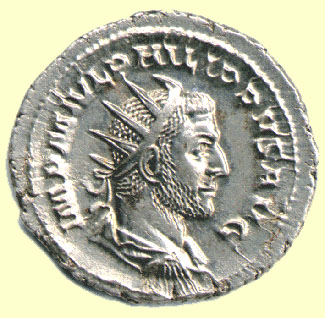 Contents -
Previous Article -
Next Article
Contents -
Previous Article -
Next Article
Radiate Crown
The radiate crown is usually associated with Sol, the sun god. Sol is shown wearing a radiate crown in portraits on coin reverses. The radiate crown was also used on the emperor’s portrait on the obverse to indicate that the coin was a double piece of two units. The copper as and the silver denarius usually had a portrait of the emperor wearing a laurel wreath. The brass dupondius usually had a radiate crown to distinguish it from the as, which was often the same size as the dupondius. When the grass and copper coins were new, they could be easily identified because the brass was yellow and the copper was reddish, but after they had circulated for a while, they both took on a brown patina. The silver radiate, known to modern coin collectors as the antoninianus, was supposedly twice the weight of the denarius but was often only slightly larger and heavier than a denarius of full weight. The Roman government was seriously cheating on the weight of the money by the time the antoninianus was introduced by Caracalla, and thus needed to make the distinction in the emperor’s headdress so the public would not be confused. The Roman people were not confused, neither were they deceived by the fudging on the weight. During the mid Third Century, the Roman economy was wracked by inflation and soon both denarius and antoninianus were underweight coins with only a thin plating of silver.
Go to next article: Mural Crown
Go back to previous article: Patera
Return to Reverse Types Table of Contents
Return to Roman Coins Table of Contents
 Contents -
Previous Article -
Next Article
Contents -
Previous Article -
Next Article